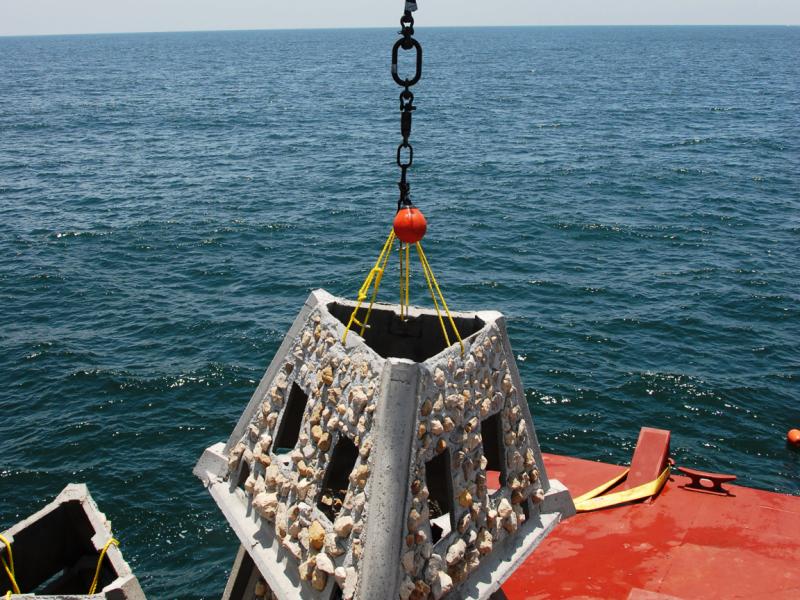The Alabama Marine Resources Division (AMRD) manages the most diverse artificial reef program in the United States.
Artificial Reef Construction Protocols
The Alabama Marine Resources Division (AMRD) has utilized a multitude of different materials over the decades to create ecologically productive reefs with decommissioned bridge spans, oil/gas platform jackets, limestone aggregate, pre-fabricated reef modules, army tanks, repurposed concrete culverts/manholes/pipes, ships, drydocks, barges and other materials of opportunity. Reefs from these materials have been constructed throughout the inshore waters of Alabama, within the nearshore waters of the Gulf of America, and up to 55 nautical miles offshore. This diversified strategy along with partnerships with the National Fish and Wildlife Foundation, Fish and Wildlife Service’s Sport Fish Restoration program, Coastal Conservation Association of Alabama, the Alabama Wildlife Federation, oil/natural gas companies, and the Alabama Gulf Coast Reef Restoration Foundation has resulted in the most productive artificial reef program in the United States.
Hard bottom substrate is very limited along the water bottoms of coastal Alabama and the addition of purposely designed artificial reefs along the predominantly featureless landscape of sand and muddy substrates has proven to be extremely effective at increasing the biomass of reef fish populations including Red snapper, Gray Triggerfish, Sheepshead, and Gray Snapper. Furthermore, constructing high quality reefs within Alabama’s coastal waters increases the connectivity between inshore, nearshore, and offshore habitats. For example, Red Drum, Sheepshead, Gray Snapper, and Southern/Gulf Flounder utilize inshore and nearshore habitats. Red Drum and Gray Snapper migrate from Alabama’s coastal rivers, bayous, and bays as juveniles and early adults to the nearshore sand bars, gas platforms, and artificial reefs as spawning adults. On the other hand, Sheepshead and flounder migrate to and from inshore waters and nearshore hard bottom habitats each year during spawning migrations. Reef construction projects throughout multiple depths offshore of Alabama also increases habitat utilization opportunities of juvenile Gray Triggerfish and Red Snapper before migrating further offshore to inhabit reefs in deeper water with more vertical complexity. Therefore, increasing the availability of a limited resource (e.g. hard bottom habitat) will increase foraging opportunities, shelter, and spawning potential of numerous fish.
During the first few years of a reef structure, numerous finfish congregate around the structure. However, the structure doesn’t have the qualities of a fully functional reef. After several years the structure becomes covered by epifaunal organisms such as oysters, mussels, barnacles, tunicates, sponges, and corals which increases small-scale rugosity (small-scale changes in surface relief) of the structure. The increased structural complexity offered by these bioengineers provides thousands of nooks and crannies for cryptic organisms such as crabs, worms, sea urchins, blennies, and other animals to use. These small cryptic organisms then serve as vectors for nutrient transfer and prey items for higher trophic level fishes and the structure becomes a true reef complete with ecological activity throughout the trophic pyramid.









